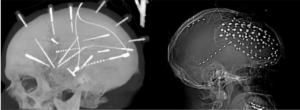In a systematic review and metaanalysis of double‑arm comparative studies Bandopadhay et al. from the Houston Methodist Hospital published in the Journal of Neurosurgery to compare safety and seizure‑outcome profiles of stereoelectroencephalography (SEEG) vs. subdural electrodes (SDE) in pharmacoresistant epilepsy using quantitative double‑arm data SEEG demonstrated a higher rate of favorable seizure outcomes (RR 1.14, 95% CI 1.02–1.27; p=0.02) and lower complication rates overall (RR 0.49, 95% CI 0.37–0.66; p<0.00001). The benefit was significant in general adult cohorts but less pronounced in pediatric or older groups 1).
Critical Appraisal
* Strengths:
-
Restricting to double‑arm designs reduces cross‑study heterogeneity.
-
Large pooled cohort: 1,632 SEEG vs. 1,482 SDE patients.
-
Age‑stratified subgroup analysis adds nuance to applicability.
* Limitations:
-
Potential for publication bias—likely underreporting of negative or null comparative studies.
-
Heterogeneity in study designs (centres, epilepsy types, electrode coverage patterns) not fully quantified (I² not reported here).
-
Age subgroups (pediatric, older) underpowered—the non‑significance in those strata may reflect type II error.
-
Safety measures lumped different complications (hemorrhage, CSF leak, infection) rather than dissecting major vs. minor morbidity.
* Rigour:
-
Appropriately rigorous methodology but missing details on heterogeneity metrics and sensitivity analysis.
-
Effect sizes modest—RR 1.14 for seizure outcome is borderline statistical significance (p=0.02).
Verdict: 7.0 /10
Valuable, well‑executed meta‑analysis supporting SEEG’s safety and efficacy advantage in adults. Slight downgrade due to lack of detailed complication stratification and limited pediatric/geriatrics power.
Takeaway for Practicing Neurosurgeons
For adult pharmacoresistant epilepsy, SEEG should be preferred when both methods are feasible—it offers improved seizure control and reduced overall complications. Be cautious in extrapolating to pediatric or elderly patients; individual risk assessment remains essential.
Bottom Line
SEEG is superior to SDE in adults for seizure outcomes and safety. Pediatric and geriatric data remain inconclusive—apply nuanced clinical judgment.
Metadata
* Title: Comparative assessment of stereoelectroencephalography and subdural electrodes in invasive epilepsy monitoring: a systematic review and meta‑analysis * Citation: Bandopadhay J, et al. Comparative assessment of stereoelectroencephalography and subdural electrodes in invasive epilepsy monitoring: a systematic review and meta‑analysis. *J Neurosurg.* 2025 Jul 4:1–9. doi:10.3171/2025.3.JNS243188 * Publication date: July 4, 2025
